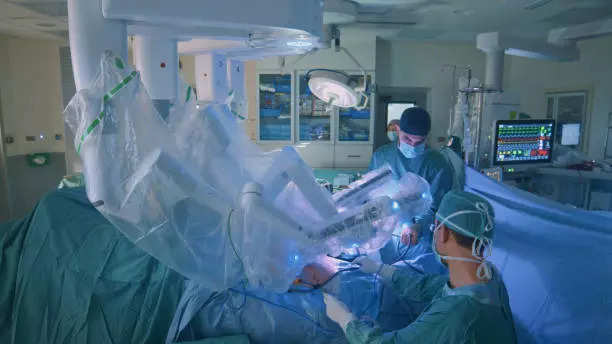Revolutionising Cancer Treatment: Oncologist Explains The Role Of Minimally Invasive Robotic Surgery in Uterine and Cervical Cancer
Robotic surgery, a remarkable subset of MIS, combines state-of-the-art robotic technology with the expertise of skilled surgeons. By utilising robotic arms to hold and manipulate surgical instruments, this approach delivers enhanced precision, dexterity, and visualisation during complex procedures.

Updated Jun 11, 2023 | 07:59 PM IST

Robotic-assisted radical hysterectomy involves the removal of the uterus, cervix, and surrounding tissues
Photo : iStock
Advancements in minimally invasive surgery (MIS), particularly robotic surgery, have transformed the landscape of cancer treatment. In the case of uterine and cervical cancer, these cutting-edge techniques offer patients improved outcomes, faster recovery, and reduced complications.
Let us delve into the fascinating world of minimally invasive robotic surgery and its impact on women’s health.
The Power of Minimally Invasive Surgery
Minimally invasive surgery (MIS) has redefined surgical procedures by employing smaller incisions, resulting in numerous benefits for patients. Compared to traditional open surgery, MIS offers reduced postoperative pain, minimal scarring, shorter hospital stays, and faster return to normal activities. Moreover, these procedures typically involve less blood loss and lower complication rates. For women battling uterine and cervical cancer, MIS represents a transformative approach that enhances their quality of life throughout treatment and recovery.
Enter Robotic Surgery
Robotic surgery, a remarkable subset of MIS, combines state-of-the-art robotic technology with the expertise of skilled surgeons. By utilising robotic arms to hold and manipulate surgical instruments, this approach delivers enhanced precision, dexterity, and visualisation during complex procedures. The surgeon operates from a console, controlling the robotic arms, which translate their hand movements into precise, scaled actions. It assimilates the advantages of open and Laparoscopic surgeries, and at the same time removing limitations of both approaches. On top of that it improves precision by removing hand tremors and providing an upto 10x magnified view to the surgeon.
The integration of robotics into gynecologic oncology has yielded tremendous progress in treating uterine and cervical cancer, setting a new standard for surgical excellence.
Uterine Cancer : A Paradigm Shift
For patients diagnosed with uterine cancer, robotic-assisted hysterectomy is now a primary treatment option. Robotic surgery offers several advantages over traditional open surgery, such as a three-dimensional, high-definition view of the surgical field, leading to improved visualization and precise surgical maneuvers. This technology enables surgeons to perform meticulous dissection and removal of the uterus and surrounding structures, minimizing trauma to healthy tissue. With the help of robotic surgery, the management of uterine cancer has witnessed significant advancements, empowering patients with improved outcomes and reduced postoperative discomfort.
Revolutionising Cervical Cancer Treatment
Robotic surgery has also transformed the management of cervical cancer. Robotic-assisted radical hysterectomy involves the removal of the uterus, cervix, and surrounding tissues. The superior visualisation and precise instrument control provided by the robotic system allow for more accurate dissection and removal of affected tissues with better never-sparing outcomes. This groundbreaking approach provides renewed hope to women battling cervical cancer and paves the way for an improved quality of life.
Final thoughts
Minimally invasive surgery, particularly robotic surgery, has ushered in a new era of cancer treatment for uterine and cervical cancer. By combining advanced technology with surgical expertise, these procedures offer patients superior outcomes, faster recovery, and reduced complications. As this field continues to evolve, the prospects for improved care and enhanced well-being for women affected by these cancers are more promising than ever before.
(The article is authored by Dr. Arun Pandey, Sr. Consultant & Head - Surgical Oncology, Asian Hospital Faridabad)
End of Article
Videos





02:08
What Are Key Differentiating Points In Poonawalla Fin Corp ? | Explains MD Abhay Bhutada

03:23
Breaking News | BJP MP Accuses Leaders Of 'Adjustment' With Congress In Karnataka, Sparks Infighting

03:38
Manipur Violence Erupts Again As Kukis, Meiteis Refuse Peace Talks| 9 Killed In Flare-Up

03:03
How MD of Poonawalla Fincorp Abhay Bhutada Started His Career ? | Business News

03:56
TMC Workers Clash In West Bengal Ahead Of Upcoming Panchayat Polls | Election News













